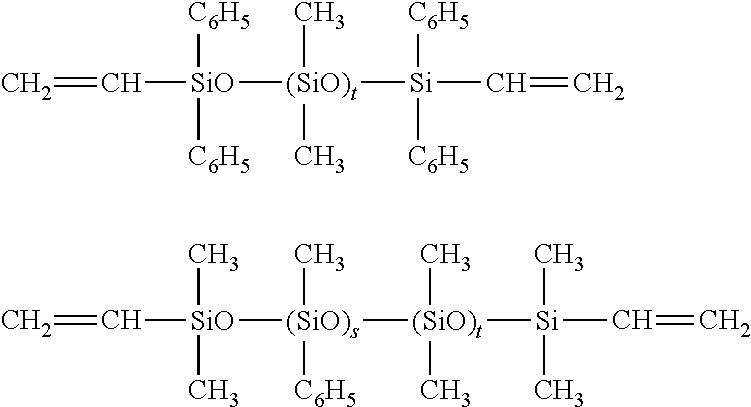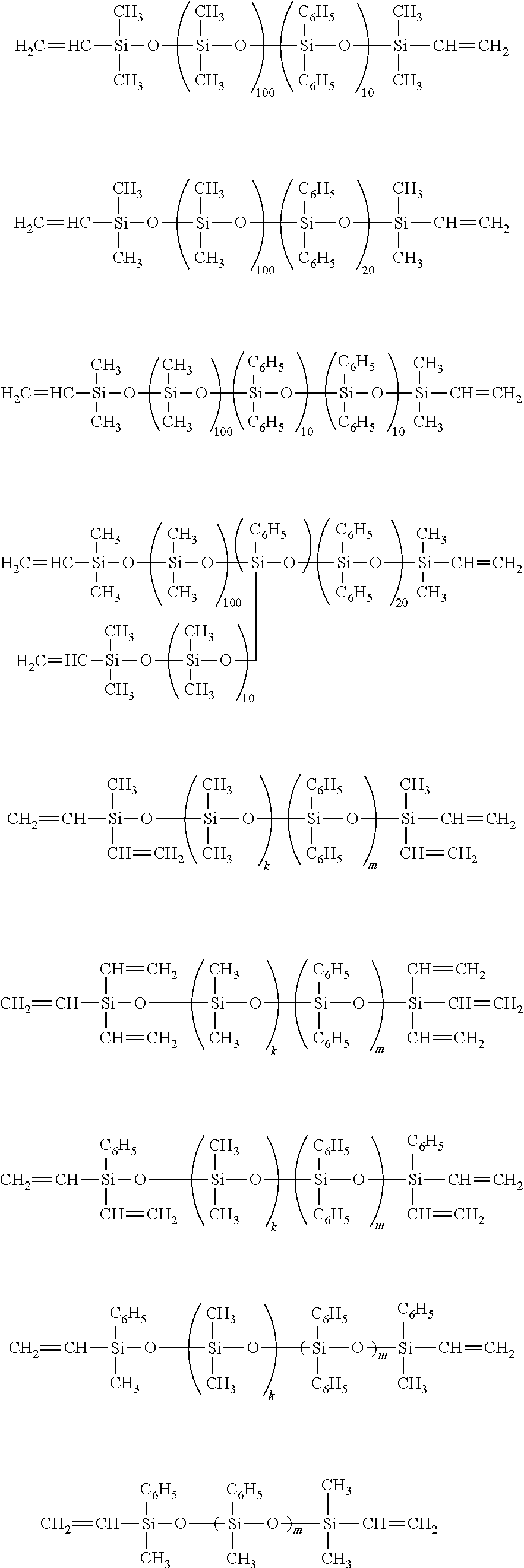Adhesion promoter, addition curable organopolysiloxane resin composition and semiconductor apparatus
a technology of organopolysiloxane and promoter, which is applied in the direction of adhesives, electrical devices, semiconductor devices, etc., can solve the problems of inconvenience, and limit heat resistance, and achieve excellent heat resistance or discoloration resistance, light resistance, and workability. excellent
- Summary
- Abstract
- Description
- Claims
- Application Information
AI Technical Summary
Benefits of technology
Problems solved by technology
Method used
Image
Examples
example 1
[0156]An organopolysiloxane resin composition was prepared by blending 5 parts of an organopolysiloxane (viscosity: 4,000 mPa·s) represented by the following formula,
[0157]wherein, l=10, and n=8, as Component (A1), 30 parts of a resin structure vinyl phenyl methyl polysiloxane (PVMQ) comprising 36 mole % of an SiO4 / 2 unit, 36 mole % of a Ph2SiO2 / 2 unit, and 28 mole % of a ViM2SiO1 / 2 unit (Mw=2,000, the hydroxyl group amount is 6% by mass, and the alkoxy group (MeO) amount is 0.2% by mass.) as Component (A2), an organohydrogen polysiloxane represented by the following formula,
[0158]wherein, v=1, with an amount that a ratio of the total number of the silicon atom-bonded hydrogen atoms in Component (B) based on the total number of the silicon atom-bonded vinyl groups in Components (A1) and (A2) (in the following, it sometimes shown as a SiH / SiVi ratio.) becomes 1.0, as Component (B), 1 part of 2-cyanoethyltriethoxysilane as Component (C), and 0.05 part of an octyl alcohol-modified solu...
example 2
[0159]In the same manner as in Example 1 except for using 30 parts of a resin structure vinyl phenyl methyl polysiloxane comprising 70 mole % of a PhSiO3 / 2 unit, 2 mole % of a ViMeSiO2 / 2 unit, and 28 mole % of a ViMe2SiO1 / 2 unit (Mw=1,800, the hydroxyl group amount is 5% by mass, the alkoxy (methoxy) group amount is 0.01% by mass.) in place of Component (A2) used in Example 1, a cured product was formed, and measurements of the physical properties were carried out. The results are shown in Table 1.
example 3
[0160]In the same manner as in Example 1 except for using 30 parts of a resin structure vinyl phenyl methyl polysiloxane comprising 40 mole % of an N≡C(CH2)2—SiO3 / 2 unit, 40 mole % of an MePhSiO2 / 2 unit, and 20 mole % of a ViMe2SiO1 / 2 unit (Mw=2,100, the hydroxyl group amount is 6% by mass, and the alkoxy (methoxy) group amount is 0.03% by mass.) in place of Component (C) used in Example 1, a cured product was formed, and measurements of the physical properties were carried out. The results are shown in Table 1.
PUM
| Property | Measurement | Unit |
|---|---|---|
| temperature | aaaaa | aaaaa |
| adhesiveness | aaaaa | aaaaa |
| adhesion | aaaaa | aaaaa |
Abstract
Description
Claims
Application Information
 Login to View More
Login to View More - Generate Ideas
- Intellectual Property
- Life Sciences
- Materials
- Tech Scout
- Unparalleled Data Quality
- Higher Quality Content
- 60% Fewer Hallucinations
Browse by: Latest US Patents, China's latest patents, Technical Efficacy Thesaurus, Application Domain, Technology Topic, Popular Technical Reports.
© 2025 PatSnap. All rights reserved.Legal|Privacy policy|Modern Slavery Act Transparency Statement|Sitemap|About US| Contact US: help@patsnap.com



